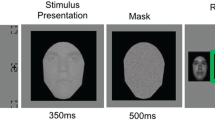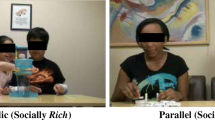Abstract
This study used eye-tracking to examine visual scanning and recognition of faces by 2- and 4-year-old children with autism spectrum disorder (ASD) (N = 44) and typically developing (TD) controls (N = 30). TD toddlers at both age levels scanned and recognized faces similarly. Toddlers with ASD looked increasingly away from faces with age, atypically attended to key features of faces, and were impaired in face recognition. Deficits in recognition were associated with imbalanced attention between key facial features. This study illustrates that face processing in ASD may be affected early and become further compromised with age. We propose that deficits in face processing likely impact the effectiveness of toddlers with ASD as social partners and thus should be targeted for intervention.




Similar content being viewed by others
References
American Psychiatric Association. (1994). Diagnostic and statistical manual of mental disorders (4th ed.). Washington DC: American Psychiatric Association.
Blair, R. J. R., Frith, U., Smith, N., Abell, F., & Cipolotti, L. (2002). Fractionation of visual memory: agency detection and its impairment in autism. Neuropsychologia, 40(1), 108–118.
Boraston, Z., Corden, B., Miles, L., Skuse, D., & Blakemore, S. (2008). Brief report: Perception of genuine and posed smiles by individuals with autism. Journal of Autism and Developmental Disorders, 38(3), 574–580.
Boucher, J., & Lewis, V. (1992). Unfamiliar face recognition in relatively able autistic children. Journal of Child Psychology and Psychiatry and Allied Disciplines, 33(5), 843–859.
Chawarska, K., & Volkmar, F. R. (2005). Autism in Infancy and Early Childhood. In: F. Volkmar, R. Paul, A. Klin, D. Cohen (Eds), Handbook of autism and pervasive developmental disorders, Vol. 1: Diagnosis, development, neurobiology, and behavior (3rd ed.).
Chawarska, K., & Volkmar, F. (2007). Impairments in monkey and human face recognition in 2-year-old toddlers with autism spectrum disorder and developmental delay. Developmental Science, 10(2), 266–279.
Chawarska, K., Paul, R., Klin, A., Hannigen, S., Dichtel, L. E., & Volkmar, F. (2007). Parental recognition of developmental problems in toddlers with autism spectrum disorders. Journal of Autism and Developmental Disorders, 37(1), 62–73.
Chawarska, K., Klin, A., Paul, R., Macari, S., & Volkmar, F. R. (in press). A prospective study of toddlers with ASD: Short-term diagnostic and cognitive outcomes. Journal of Child Psychology and Psychiatry.
Chawarska, K., Shic, F., Bradshaw, J., Macari, S., & Klin, A. (2009a). Atypical face scanning in high-risk infants. Presentation at the international conference of infancy studies, Chicago, IL.
Chawarska, K., Shic, F., & Macari, S. (2009b). Context matters: Development of face scanning strategies infancy, (manuscript in preparation).
Dalton, K. M., Nacewicz, B. M., Johnstone, T., Schaefer, H. S., Gernsbacher, M. A., Goldsmith, H., et al. (2005). Gaze fixation and the neural circuitry of face processing in autism. Nature Neuroscience, 8(4), 519–526.
Dapretto, M., Davies, M. S., Pfeifer, J. H., Scott, A. A., Sigman, M., Bookheimer, S. Y., et al. (2006). Understanding emotions in others: Mirror neuron dysfunction in children with autism spectrum disorders. Nature Neuroscience, 9(1), 28–30.
De Giacomo, A., & Fombonne, E. (1998). Parental recognition of developmental abnormalities in autism. European Child and Adolescent Psychiatry, 7(3), 131–136.
Duchowski, A. T. (2003). Eye tracking methodology: Theory and practice (1st ed.). Heidelberg: Springer.
Fantz, R. (1964). Visual experience in infants: Decreased attention familiar patterns relative to novel ones. Science, 146(3644), 668–670.
Gallay, M., Baudouin, J.-Y., Durand, K., Lemoine, C., & Lecuyer, R. (2006). Qualitative differences in the exploration of upright and upside-down faces in four-month-old infants: An eye-movement study. Child Development, 77(4), 984–996.
Gepner, B., de Gelder, B., & de Schonen, S. (1996). Face processing in autistics: Evidence for a generalized deficit? Child Neuropsychology, 2(2), 123–139.
Golarai, G., Grill-Spector, K., & Rice, A. L. (2006). Autism and the development of face processing. Clinical Neuroscience Research, 6, 145–160.
Gotham, K., Risi, S., Pickles, A., & Lord, C. (2007). The autism diagnostic observation schedule: Revised algorithms for improved diagnostic validity. Journal of Autism and Developmental Disorders, 37(4), 613–627.
Hainline, L. (1978). Developmental changes in visual scanning of face and nonface patterns by infants. Journal of Experimental Child Psychology, 25(1), 90–115. Feb 1978.
Haith, M. M., Bergman, T., & Moore, M. (1977). Eye contact and face scanning in early infancy. Science, 218, 179–181.
Hayhoe, M., & Ballard, D. (2005). Eye movements in natural behavior. Trends in Cognitive Sciences, 9(4), 188–194.
Heisz, J. J., & Shore, D. I. (2008). More efficient scanning for familiar faces. Journal of Vision, 8(1), 1–10.
Henderson, J. M. (2003). Human gaze control during real-world scene perception. Trends in Cognitive Sciences, 7(11), 498–504.
Henderson, J. M., Williams, C. C., & Falk, R. J. (2005). Eye movements are functional during face learning. Memory & Cognition, 33(1), 98–106.
Jones, W., Carr, K., & Klin, A. (2008). Absence of preferential looking to the eyes of approaching adults predicts level of social disability in 2-year-olds with autism spectrum disorder. Archives of General Psychiatry, 65(8), 946–954.
Joseph, R. M., & Tanaka, J. (2003). Holistic and part-based face recognition in children with autism. Journal of Child Psychology and Psychiatry, 44(4), 529–542.
Kaplan, P., Werner, J., & Rudy, J. (1990). Habituation, sensitization, and infant visual attention. Advances in infancy research, 6, 61–109.
Klin, A., Sparrow, S. S., de Bildt, A., Cicchetti, D. V., Cohen, D. J., & Volkmar, F. R. (1999). A normed study of face recognition in autism and related disorders. Journal of Autism and Developmental Disorders, 29(6), 499–508.
Klin, A., Jones, W., Schultz, R., Volkmar, F., & Cohen, D. (2002). Visual fixation patterns during viewing of naturalistic social situations as predictors of social competence in individuals with autism. Archives of General Psychiatry, 59(9), 809–816.
Klin, A., Lin, D., Gorrindo, P., Ramsay, G., & Jones, W. (2009). Two-year-olds with autism orient to non-social contingencies rather than biological motion. Nature, 459(7244), 257–261. doi: 10.1038/nature07868.
Langdell, T. (1978). Recognition of faces: An approach to the study of autism. Journal of Child Psychology and Psychiatry, 19, 255–268.
López, B., Donnelly, N., Hadwin, J. A., & Leekam, S. R. (2004). Face processing in high-functioning adolescents with autism: Evidence for weak central coherence. Visual Cognition, 11(6), 673–688.
Lord, C., Risi, S., Lambrecht, L., Cook, E. H., Leventhal, B. L., DiLavore, P. C., et al. (2000). The autism diagnostic observation schedule-generic: A standard measure of social and communication deficits associated with the spectrum of autism. Journal of Autism and Developmental Disorders, 30(3), 205–223.
Lundqvist, D., Flykt, A., & Öhman, A. (1998). The Karolinska Directed Emotional Faces—KDEF, CD ROM from Department of Clinical Neuroscience, Psychology section, Karolinska Institutet, ISBN 91-630-7164-9.
Mathworks, Inc. (2004). MATLAB 7.0 (Release 14).
Maurer, D., & Salapatek, P. (1976). Developmental changes in the scanning of faces by young infants. Child Development, 47(2), 523–527.
Morgan, K., & Hayne, H. (2006). The effect of encoding time on retention by infants and young children. Infant behavior & development, 29, 599–602.
Mullen, E. (1995). Mullen scales of early learning (AGS Edition ed.). Circle Pines, MN: American Guidance Serivce, Inc.
Neumann, D., Spezio, M. L., Piven, J., & Adolphs, R. (2006). Looking you in the mouth: Abnormal gaze in autism resulting from impaired top-down modulation of visual attention. Social Cognitive and Affective Neuroscience, 1(3), 194–202.
Neurobehavioral Systems. (2005). Presentation. Version 10.1. www.neurobs.com.
Pascalis, O., & de Haan, M. (2003). Recognition memory and novelty preference: What model? Progress in Infancy Research, 3, 95–120.
Paul, R. (2008). Communication development and assessment. In K. Chawarska, A. Klin, & F. Volkmar (Eds.), Autism in infants and toddlers: Diagnosis, assessment and treatment. New York, NY: Guilford Press.
Paul, R., Chawarska, K., Fowler, C., Cicchetti, D., & Volkmar, F. (2007). “Listen my children and you shall hear”: Auditory preferences in toddlers with autism spectrum disorders. Journal of Speech, Language and Hearing Research, 50(5), 1350–1364.
Pelphrey, K. A., Sasson, N. J., Reznick, J., Paul, G., Goldman, B. D., & Piven, J. (2002). Visual scanning of faces in autism. Journal of Autism and Developmental Disorders, 32(4), 249–261.
Pierce, G. L., & Henderson, J. M. (2007). The control of fixation duration during scene perception. Visual Cognition, 15(1), 108–112.
Richards, J. E. (1997). Effects of attention in infants’ preference for briefly exposed visual stimuli in the paired-comparison recognition-memory paradigm. Developmental Psychology, 33, 22–31.
Robinson, A. J., & Pascalis, O. (2004). Development of flexible visual recognition memory in human infants. Developmental Science, 7(5), 527–533.
Rose, S. A., Gottfried, A. W., Melloy-Carminar, P., & Bridger, W. H. (1981). Familiarity and novelty preference in infant recognition memory: Implications for information processing. Developmental Psychology, 18, 704–713.
Rutherford, M., & Towns, A. (2008). Scan path differences and similarities during emotion perception in those with and without autism spectrum disorders. Journal of Autism and Developmental Disorders, 38(7), 1371–1381. doi: 10.1007/s10803-007-0525-7.
Rutter, M., Le Couter, A., & Lord, C. (2003). ADI-R: Autism diagnostic interview-revised. Los Angeles, CA: Western Psychological Services.
SAS Institute Inc. (2004). SAS 9.1.3 Help and Documentation, Cary, NC: SAS Institute Inc., (2000–2004).
Schultz, R. T. (2005). Developmental deficits in social perception in autism: The role of the amygdala and fusiform face area. International Journal of Developmental Neuroscience, 23(2–3), 125–141.
Schyns, P. G., Bonnar, L., & Gosselin, F. (2002). Show me the features! Understanding recognition from the use of visual information. Psychological Science, 13(5), 402–409.
Sensomotoric Instruments (2005). iView X (TM) RED.
Shic, F. (2008). Computational methods for eye-tracking analysis: Applications to autism. Ph.D. thesis, Yale University.
Shic, F., Chawarska, K., Lin, D., & Scassellati, B. (2007). Measuring context: The gaze patterns of children with autism evaluated from the bottom-up. Development and learning, 2007. ICDL IEEE 6th international conference on. pp. 70–75.
Speer, L. L., Cook, A. E., McMahon, W. M., & Clark, E. (2007). Face processing in children with autism. Autism, 11(3), 265–277.
Sterling, L., Dawson, G., Webb, S., Murias, M., Munson, J., Panagiotides, H., et al. (2008). The role of face familiarity in eye tracking of faces by individuals with autism spectrum disorders. Journal of Autism and Developmental Disorders, 38, 166–1675.
van der Geest, J. N., Kemner, C., Verbaten, M. N., & van Engeland, H. (2002). Gaze behavior of children with pervasive developmental disorder toward human faces: A fixation time study. Journal of Child Psychology and Psychiatry and Allied Disciplines, 43(5), 669–678.
Wallace, S., Coleman, M., & Bailey, A. (2008). An investigation of basic facial expression recognition in autism spectrum disorders. Cognition & Emotion, 22(7), 1353–1380.
Wolfe, J. M., & Horowitz, T. S. (2004). What attributes guide the deployment of visual attention and how do they do it? Nature Reviews Neuroscience, 5(6), 495–501.
Acknowledgments
The study was supported by the NAAR foundation (to KC), NIMH grant T32 MH18268 (to FS), and NIMH STAART grant U54 MH66494 (to KC). We would like to thank Jessica Bradshaw for her work in preparation of this data for analysis; Fred Volkmar, Ami Klin, and Suzanne Macari for helpful suggestions on earlier versions of the manuscript; and Celine Saulnier for her contribution to sample characterization. We wish to express our deep appreciation to the children and families who participated in the study.
Author information
Authors and Affiliations
Corresponding author
Rights and permissions
About this article
Cite this article
Chawarska, K., Shic, F. Looking But Not Seeing: Atypical Visual Scanning and Recognition of Faces in 2 and 4-Year-Old Children with Autism Spectrum Disorder. J Autism Dev Disord 39, 1663–1672 (2009). https://doi.org/10.1007/s10803-009-0803-7
Received:
Accepted:
Published:
Issue Date:
DOI: https://doi.org/10.1007/s10803-009-0803-7




